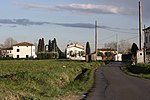The Virgo interferometer is a large Michelson interferometer designed to detect gravitational waves predicted by general relativity. It is located in Santo Stefano a Macerata, near the city of Pisa, Italy. The instrument's two arms are three kilometres long, housing its mirrors and instrumentation inside an ultra-high vacuum.
Virgo is hosted by the European Gravitational Observatory (EGO), a consortium founded by the French CNRS and Italian INFN. The Virgo Collaboration operates the detector and defines the strategy and policy for its use and upgrades. It is composed of several hundreds of members across 16 different countries. Other interferometers similar to Virgo have the same goal of detecting gravitational waves, including the two LIGO interferometers in the United States (at the Hanford Site and in Livingston, Louisiana) and the Japanese interferometer KAGRA. Since 2007, Virgo and LIGO have agreed to share and jointly analyze the data recorded by their detectors and to jointly publish their results; this agreement now includes KAGRA since 2019. Because the interferometric detectors are not directional (they survey the whole sky) and are looking for signals which are weak and infrequent, simultaneous detection of a gravitational wave in multiple instruments is crucial for improving the confidence in the signal validity and deducing the location of its source.
The interferometer is named after the Virgo Cluster, a cluster of about 1,500 galaxies in the Virgo constellation, about 50 million light-years from Earth. Born at a time when gravitational waves were only a prediction from general relativity, it has now participated in detecting multiple gravitational wave events; the detector is still being periodically improved to increase its sensitivity and its scientific output.









